The content of the article
Over the past 10 years, Japanese cuisine has gained rapid popularity, as a result of which sushi chefs come up with new recipes every month, and this is not surprising. If you look at the pricing policy of restaurants or boutiques where take-away rolls are sold, we can conclude that their revenues are excellent. However, not everyone can afford to boast like this every week, hence the need for training in culinary art. Rolls can be prepared on their own, because even in small towns there are the necessary ingredients.
Roll Composition
Before talking about how to cook rolls, you need to understand what is included in them and what should be this or that product. Consider the important aspects in order.
- Fig. Japanese craftsmen and cooks working in such establishments use special sushi rice called Nishiki. The product is a round grain with a high starch content. Due to this feature, rice sticks together so well after cooking, so the rolls do not fall apart. As a rule, the pricing policy of such rice is quite large, so it makes sense to consider other options. Choose any round-grain or medium-grain rice, but not steamed, otherwise it will not stick together.
- Ginger. In most cases, the main property of ginger is considered to be its antimicrobial effect. The product kills bacteria found in raw fish. In fact, not everyone knows about it, but ginger is used along with rolls to interrupt the taste when you eat several types of sushi.
- Nori. They are sheets of seaweed in which rice and roll filling are wrapped. Nori is produced from a red species of algae, they more fully reveal the taste of the dish. The product is rich in many vitamins, including groups A, B, C, D, E, which a person needs for a full life. As for the variety, there are three types of nori: A, B, C. The former are considered to be the highest class, they are better and denser.
- Soy sauce. It is difficult to imagine the use of rolls and sushi without soy sauce. It gives the dish piquancy, sophistication and lightness. In addition, soy sauce is good for the heart and liver if it is produced by the natural method of fermentation. When choosing a product, pay attention to the "Composition" column; it should not contain unfamiliar components. Soy sauce is made from wheat and soybeans, vinegar, sugar and salt. In some cases, garlic is added during the manufacturing process.
- Wasabi. The product is a paste or powder composition. Wasabi is a horseradish that comes in two forms: sava and seio. Seio horseradish is most often found, since it is cheaper and belongs to the economy segment. It doesn’t matter what type you choose, in terms of taste they are almost identical. As for the consistency, buy wasabi powder, which is diluted with water to a state of thick sour cream (it is completely natural).
- Rice Vinegar Serves to add a sweet taste to rice. Vinegar also glues grains, and then for a long time retains a peculiar sticky consistency, which does not allow the roll to disintegrate. The best option for the product is considered to be real Japanese vinegar, on the label of which there are no signs in other languages.
Rice preparation technology for rolls
The basis for the preparation of rolls at home is quality cooked rice.As mentioned earlier, choose a special composition or product with round grains that contains the highest amount of starch.
- Cooking a Japanese dish begins with thoroughly washing the rice in cold water. To do this, add ice cubes, rice grains and plain running / filtered water to the pan, leave for half an hour, then proceed with washing. As practice shows, it is necessary to do 10-12 repetitions, so that ultimately the water becomes crystal clear.
- Place the washed rice in a pan with thick walls and a bottom. Pour cold (!) Water per 1 kg. rice / 1.5 l. water. Cover, turn on medium heat and bring the composition to a boil. After the appearance of the first bubbles, reduce the heat to a minimum mark, cook another 10-12 minutes. After the expiration of the time, turn off the burner, do not open the lid, leave the product for half an hour. Then move the rice to another container, leave to cool to room temperature.
- When you cooked the grains, you can proceed to the next step - preparing rice dressing using Japanese technology. There are several options, consider them in order.
Apple cider vinegar dressing. It is not necessary to use special vinegar for sushi, and the traditional apple composition is quite suitable. It is important to understand that such a technology will change palatability, but not to a great extent. Buy a 6% solution of apple cider vinegar in a health food store, pour 60 ml. product in an enamel pan and put on a slow fire. Wait for boiling, then pour in 30 ml. purified water, pour 75 g. granulated sugar (preferably cane), add 30 gr. salt. Bring the composition to homogeneity, stir it with a wooden spoon. Once the pellets have melted, remove the dressing from the stove.
Rice vinegar-based dressing. Of course, this species is more traditional. If possible, prepare the rolls precisely by this technique. Connect among themselves 35 gr. sugar and 35 gr. chopped salt, pour 100 ml. rice vinegar. Put on medium heat, wait for the mixture to boil, then immediately set the minimum mode. Constantly stir the composition so that it does not burn. Refueling is considered finished at the moment when salt and granulated crystals have melted. After that, it must be cooled to room temperature and mixed with rice.
Roll Twisting Technique
Rolls are internal and external. In the first case, rice is inside nori along with other ingredients. In the second version, the rice is twisted outward, and the filling remains inside. In order to properly roll the roll, you need to purchase a bamboo mat, and then wrap it with cling film so that the grains do not stick to the rug.
Domestic rolls
- Place a container of water next to it, dilute the salt in it, and wait for the crystals to dissolve.
- Cut the nori leaf into 2 equal parts, leave one of them. Lay it on the mat with the glossy side down.
- Dip your hands in acidified water, scoop a handful of rice and roll a ball from it.
- Put it in the middle of the sheet, step back 1 cm from the top edge of the nori (do not put rice on this area). Roll out the grains in an even layer, constantly wet your hands so that the composition does not stick.
- Spread the filling closer to the bottom edge with thin strips, do not overdo it, otherwise the roll will not completely wrap. For the first time, it is recommended to put less than more.
- Pull the nori sheet with the rice already applied to the bottom of the mat. Lift the bamboo mat along with the roll and start twisting it into the cylinder. Hold the filling with your fingers.
- When you reach almost to the end, soak your finger in water and draw it along the indentation line in the upper section. This must be done so that the roll sticks well.
- Continue wrapping it until the edges of the nori touch and fasten. After that, slide your hands through the mat along the cylinder, squaring the roll.
- Soak a sharp knife in cold water, cut the resulting roll first into 2 equal parts, and then divide each section into 3-4 more pieces (optional).
External rolls
All famous rolls are cooked in this way. The most common Japanese dishes include the Philadelphia, California, Caesar rolls.
- Cut the nori in half, take one part and lay it with the glossy side down on the mat.
- Wet your hands in cold filtered water, scoop a handful of rice and roll the ball.
- Now be extremely careful. Distribute the grains so that the rice layer protrudes 1 cm from the bottom edge of the mat (it turns out that this area will lie on the rug). At the same time, you need to step back 1 cm from the top edge (there should be no rice in this zone).
- Crumple the surface with your fingers to make it even; pay special attention to the edges. Then pry one piece and turn the roll upside down.
- Spread the desired ingredients on the nori surface, stick to the bottom. Now lift the mat, grabbing the algae, start twisting the roll into a roll.
- As in the previous case, give the roll a square shape, cut first into 2 sections, then another 3.
Popular rolls
- "Philadelphia". Rolls are prepared according to the principle of external twisting, in which rice is turned inside out. When you turn the nori, put cream cheese, slices of avocado or cucumber on it, then roll it up. Cut the salmon into thin slices, put on top of the rice, twist with a bamboo mat to make it stick. Cut into equal pieces with a sharp knife dipped in cold water.
- "Caesar". Grind the chicken into thin slices, then fry until golden brown. Cut the tomato into straws, do the same with the lettuce leaf. Spread the rice on the nori, turn it inside out. Lubricate the algae with Caesar dressing or garlic mayonnaise. Lay chicken, lettuce, tomato on top, grate hard cheese so that it covers all the ingredients. Twist the roll. Break the egg yolk into a bowl, salt it and beat with a whisk. Cook a thin pancake in a pan, place it on a roll and wrap. Cut the roll into equal sections, serve with nut sauce.
- "California". The roll is being prepared externally. Lubricate the inverted surface of the nori with cream cheese, put medium-sized shrimps or crab meat, add slices of cucumber and slices of fresh pineapple (optional). Roll the roll, sprinkle it with tobiko caviar of any color, use the mat again so that the grains of caviar do not fall. Cut the roll into pieces.
If you have sufficient knowledge regarding the technology of cooking rolls, difficulties should not arise. We have given the most common recipes that can easily be made at home. Now you know how the external and internal rolls are twisted, which means you can realize any option you like about a Japanese dish found on the Internet or in the menu of your favorite Japanese restaurant.
Video: how to cook sushi - step by step instructions

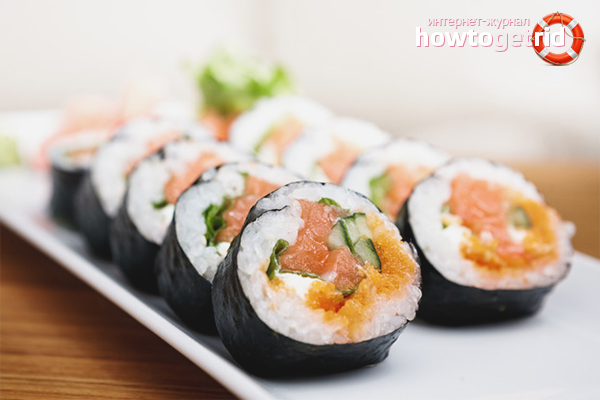

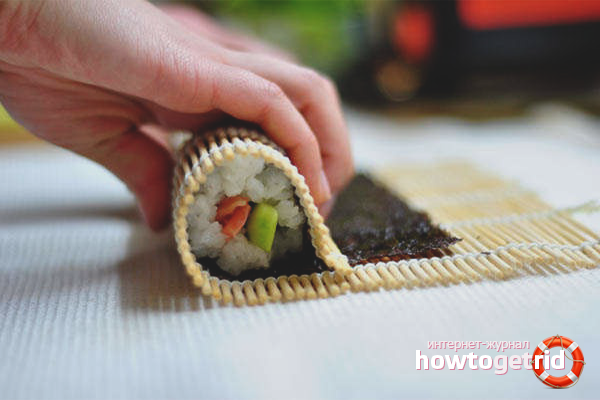
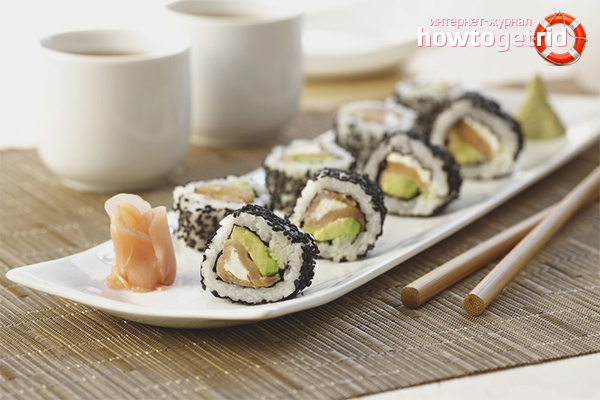
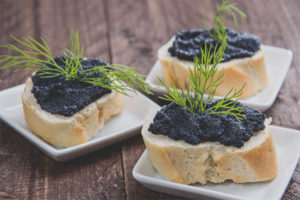
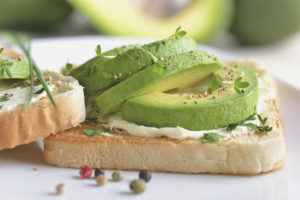
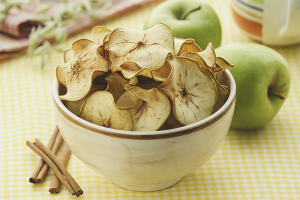


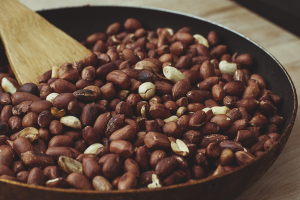
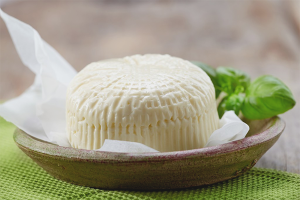
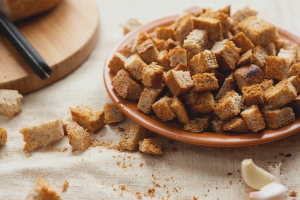
Submit